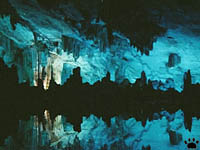
Ludiyan Cave, Yunnan, China.
Part 5. Caves of East Asia
Southeast Asia has extensive limestone areas and very wet climate,
so it's not surprising that some of its caves are among the most impressive in
the World.

Gunung (Mountain) Mulu, Sarawak. Deer Cave
entrance visible in the center of the photo. |
It also has the most beautiful tower
carst landscapes on our planet. The area around Guilin, China,
is the best, but Halong Bay in Vietnam and Gunung Mulu National Park in Sarawak
are also very scenic. |
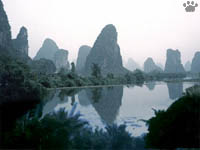
Tower karst near Longshen village, south from
Guilin, Southern China. |

View from a small
cave, Longshen. |

Reed Flute Cave,
Guilin, China. |
All tower karst areas are riddled with
caves. The most picturesque of China's numerous karst caves, Ludi Yan (Reed Flute
Cave) is near Guilin. There are also many "wild" caves in the area,
some with cave snakes and other interesting wildlife. |

Reed Flute Cave,
Guilin, China. |

Reed Flute Cave,
Guilin, China. |

Good Luck Cave, Gunung Mulu. |
Gunung Mulu National Park has the World's
largest cave chambers. Sarawak Chamber in Good Luck Cave is 700 m long, 30 m wide,
and 70 m high. Deer Cave is smaller, but you could still fly a helicopter through
it. |
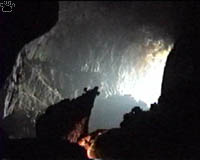
Deer Cave, Gunung Mulu. |
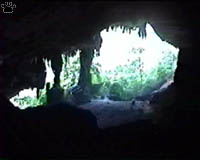
Lang Cave, Gunung Mulu. |
Nearby Clearwater Cave is the longest
in Asia (107 km) and has a nice subterranean river, while smaller Lang and Wind
caves in the same area have some interesting formations. |
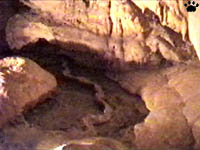
Clearwater Cave, Gunung Mulu. |

Skylights allow birds such
as cave thrushes to survive
deep into Deer Cave. |

This formation is typical for
Lang Cave. It is probably
an evidence of air flow. |
The most unique formations in Gunung
Mulu are called "Eden showers"
(right). |
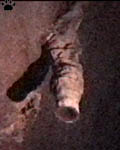
These tubes are up to 10 m
long, to 1 m in diameter, and
produce a lot of water. |
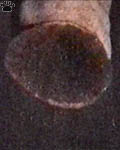
The interior of these colossal
"showers" is covered with
some beautiful crystals. |
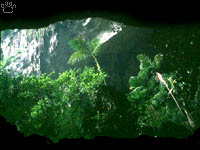
Deer Cave, Gunung Mulu. |
All Gunung Mulu caves have lots of
bats, but only Deer Cave has a "bat cave" ecosystem with cave fishes,
cave geckos, and many other creatures dependent on bat guano and dead bats. |

Deer Cave also has a small river. |
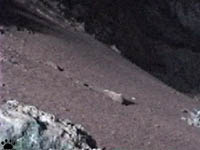
Mountain of bat guano, Deer Cave. |
A colony of approximately 3 million
freetail bats (Tadarida plicata) inhabits Deer Cave. But the cave is so
large that the colony looks like small black spot from below. |
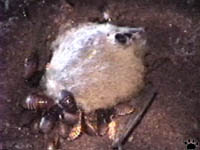
Cockroaches on a dead bat, Deer Cave. |

Cave thrush
(Myophonus glaucinus), Deer Cave. |
Deer Cave has the World's most spectacular
bat flights. As millions of bats fly out at dusk in tornado-like formations, hundreds
of thousands of cave swiftlets come back into the cave. At dawn, everything goes
in reverse. Despite heavy traffic, I've never seen a mid-air collision at the
cave entrance, but bat hawks (Macheiramphus alcinus) catch some bats and
birds occasionally. |
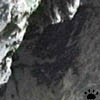
These black spots are
millions of free-tailed
bats. Deer Cave. |

Miniopterus pusillus
bats, Lang Cave. |
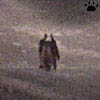
Kerivoula minuta bat,
Niah Caves. |
Gomantong Caves in Sabah (also on Malaysian
Borneo) are a somewhat more accessible place to see bat/swiftlet flights. |
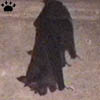
Hipposideros galeritus
bat, Gunung Mulu. |
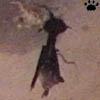
Bat Rhinolophus
acuminatus, Deer Cave. |
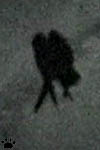
Edible-nest swiftlet
(A. fuciphagus),
Deer Cave. |
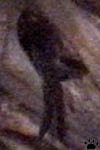
Black-nest swiftlet
(A. maximus),
Niah Cave. |
For centuries, Gomantong Caves and
Niah Caves of Sarawak have been a major source of income for local villages. People
collect edible nests of cave swiftlets (Aerodramus) for sale to Chinese
restaurants. It is a dangerous job, not for people uncomphortable with hights. |
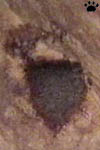
Black-nest swiftlets'
(A. maximus)
nest, Niah Cave. |

Mossy-nest swiftlets'
(A. salangana)
nests, Lang Cave. |
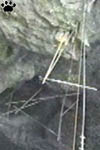
Climbing scaffold,
Niah Caves. |
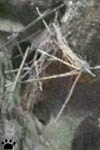
Climbing scaffold,
Niah Caves. |
The nest hunters use flimsy scaffolds
made of bamboo to climb to the nests 50-100 m above the cave floor, and spend
many hours crawling from nest to nest with no rock-climbing equipment at all.
Accidents are common in swiftlet caves. |
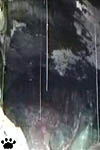
Climbing sticks,
Niah Caves. |
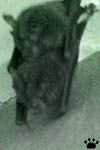
Mating Rh. borneensis
bats, Niah Caves. |
|

Rh. lepidus bats hanging on
each other, Gua Telinga.
|
Small caves often
have wildlife different from large ones, and more accessible for study. A tiny
cave called Gua Telinga in Taman Negara National Park, Malaysia, has eight species
of horseshoe-nosed bats, fed upon by rare cave snakes and predatory false vampire
bats. |
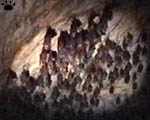
Large mixed group of Rhinolophus
bats, Gua Telinga. |

Family of Asian false vampires
(Megaderma lyra), Gua Telinga. |
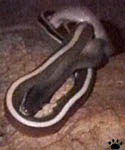
Cave snake (Elaphe taeniura
ridleyi), Gua Telinga. |
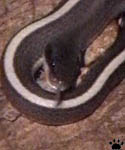
Cave snake (Elaphe taeniura
ridleyi), Gua Telinga. |

Family of Asian false vampires
(Megaderma lyra), Gua Telinga. |
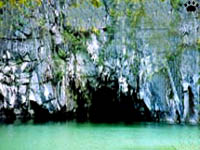
Mouth of Saint Paul Subterranean River, Palawan. |
Horseshoe bats
are the main attaction of Philippine caves, such as Macahambus Cave near Cagayan
de Oro on Mindanao, and numerous caves around Sagada on Luzon. |
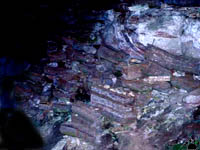
Ancient coffins in a cave near Sagada, Luzon. |
|
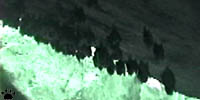
Rh. acuminatus bats, Saint Paul's Subterranean
River, Palawan.
|
The most interesting cave on the islands
is beautiful 10 km-long St. Paul's Subterranean River on Palawan. In addition
to various bats and swiftlets, it has giant ghost shrimp. |
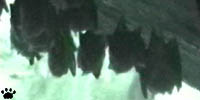
Rh. inops bats, Saint Paul's Subterranean River,
Palawan. |
|
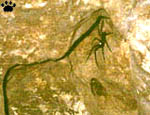
Cave spider, Makahambus Cave,
Mindanao.
|
Many carst areas of Asia are still unexplored. New caves are being discovered every year. Never miss a chance to explore a cave - who knows what undergroud wonders are hidden in the forests and mountains of that wonderful continent. |

Cave spider, Bat Cave,
Poring Hot Springs, Sabah. |
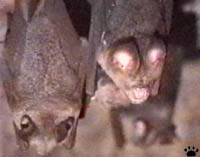
Rh. macrotis bats, Mahendra Cave, Pokhara, Nepal. |
Part 6. Caves of Madagascar and Africa
Back to Part 4
Home
|